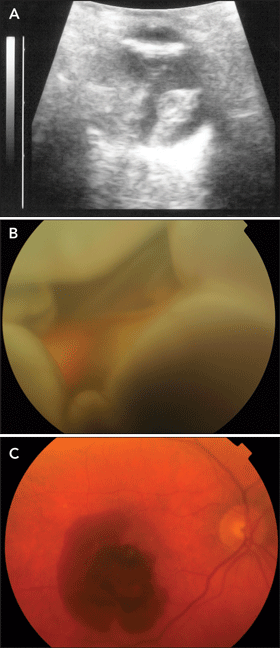Clinical record
Age-related macular degeneration affects about one-third of people aged over 75 years.1 Of those with AMD, 10%–15% develop the neovascular (“wet”) form,2 characterised by abnormal new blood vessel formation in the choroid, under the retina. These abnormal vascular membranes are prone to rupture, leading to subretinal bleeding, fibrous scar formation and severe visual loss.
Many older patients who have AMD also take medications that can exacerbate or promote bleeding, such as anticoagulants or antiplatelet agents. In rare cases, intraocular bleeding — in the form of subretinal, suprachoroidal, or vitreous haemorrhage — can be catastrophic and blinding. Previous reports link systemic anticoagulation therapy to intraocular haemorrhage and blindness in AMD patients,3-7 including a recent report in this Journal.8 In two of these reports, patients taking warfarin had very high INRs (4.1 in one case;3 6.3 in the other4).
Other reports link systemic anticoagulation therapy to spontaneous suprachoroidal haemorrhage, even in the absence of neovascular AMD.9-11 Additionally, patients with neovascular AMD can develop massive submacular haemorrhage, even if they are not taking antiplatelet or anticoagulant agents. Unfortunately, as many patients with AMD have one eye with poor visual acuity due to macular scarring, it is all the more catastrophic when a massive haemorrhage leads to blindness in their “good” eye.
It has been previously noted that if a patient has only one functioning eye, the patient’s general practitioner or cardiologist should seek an ophthalmologist’s opinion to assess the risk of neovascular AMD in the seeing eye before, or soon after, commencing warfarin.12 Further, ophthalmologists should ask their patients whether they take warfarin, and should communicate to the treating doctor whether a patient has, or is at high risk of developing, neovascular AMD.12
Patients taking warfarin who develop neovascular AMD should be advised to maintain an INR at the lower end of the recommended range.3 In addition, we recommend that it would be prudent for INR monitoring to be at the more frequent end of the spectrum.
Lessons from practice
Patients taking warfarin who develop neovascular age-related macular degeneration (AMD) should maintain an international normalised ratio (INR) at the lower end of the recommended range.
INR monitoring should be more frequent for patients with neovascular AMD.
If a patient has only one functioning eye, an ophthalmologist should assess the risk of developing neovascular AMD in the seeing eye before, or soon after, commencing warfarin or an antiplatelet agent, including aspirin.
Ophthalmologists should ask all patients whether they take warfarin, and should communicate to the treating doctor whether this patient has, or is at high risk of developing, neovascular AMD.
- 1. Klein R, Klein BE, Linton KL. Prevalence of age-related maculopathy. The Beaver Dam Eye Study. Ophthalmology 1992; 99: 933-943.
- 2. Ferris FL 3rd, Fine SL, Hyman L. Age-related macular degeneration and blindness due to neovascular maculopathy. Arch Ophthalmol 1984; 102: 1640-1642.
- 3. Ung T, James M, Gray RH. Long term warfarin associated with bilateral blindness in a patient with atrial fibrillation and macular degeneration. Heart 2003; 89: 985.
- 4. Knox FA, Johnston PB. Spontaneous suprachoroidal haemorrhage in a patient with age-related macular degeneration on excessive anticoagulation therapy. Eye 2002; 16: 669-670.
- 5. Alexandrakis G, Chaudhry NA, Liggett PE, Weitzman M. Spontaneous suprachoroidal hemorrhage in age-related macular degeneration presenting as angle-closure glaucoma. Retina 1998; 18: 485-486.
- 6. Edwards P. Massive choroidal hemorrhage in age-related macular degeneration: a complication of anticoagulant therapy. J Am Optom Assoc 1996; 67: 223-226.
- 7. Lewis H, Sloan SH, Foos RY. Massive intraocular hemorrhage associated with anticoagulation and age-related macular degeneration. Graefes Arch Clin Exp Ophthalmol 1988; 226: 59-64.
- 8. Chalasani R, Qureshi S. Anticoagulation and intraocular haemorrhage in age-related macular degeneration: a probable link? Med J Aust 2010; 192: 228-229. <MJA full text>
- 9. Khawl JA, Ferrone PJ, Holck DEE. Choroidal hemorrhage associated with systemic plasminogen activator. Am J Ophthalmol 1996; 121: 577-578.
- 10. Chorich LJ, Derick RJ, Chambers RB, et al. Hemorrhagic ocular complications associated with systemic tissue thrombolytic agents. Ophthalmology 1998; 105: 428-431.
- 11. Wong JS. Spontaneous suprachoroidal hemorrhage in a patient receiving low-molecular-weight heparin (fraxiparine) therapy. Aust N Z J Ophthalmol 1999; 27: 433-434.
- 12. Kowal LM, Harper CA. Visual complications of warfarin [letter]. Med J Aust 2002; 176: 351.






None identified.